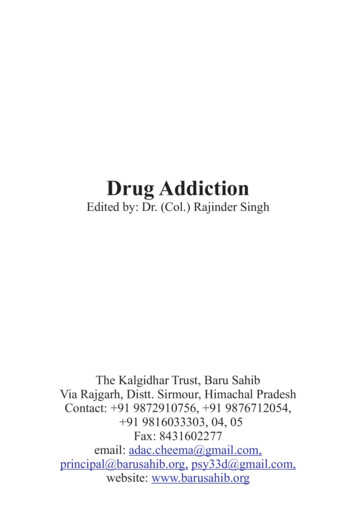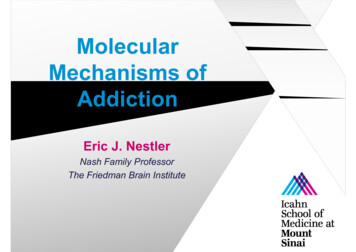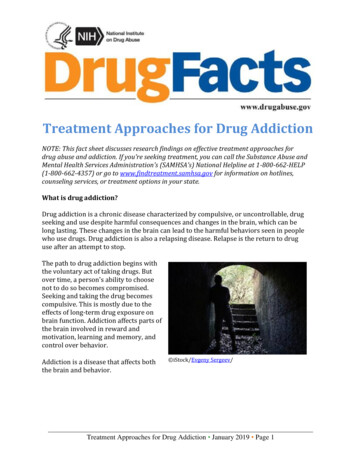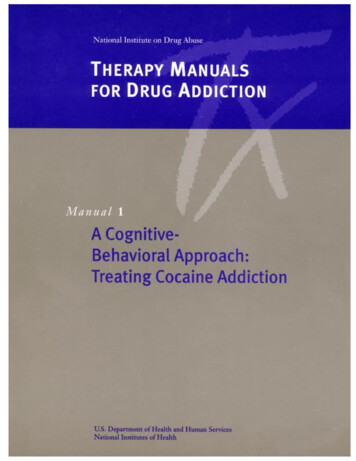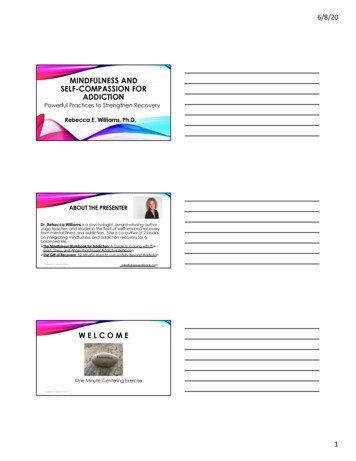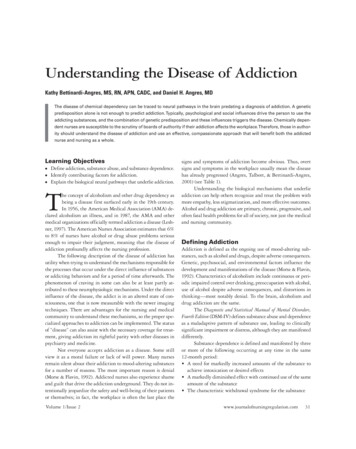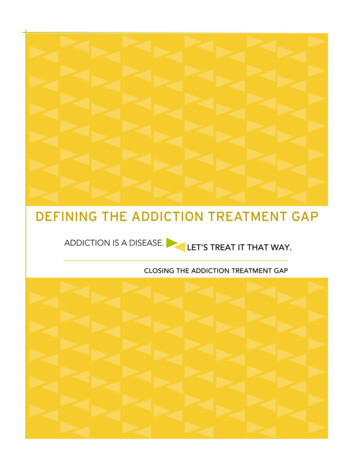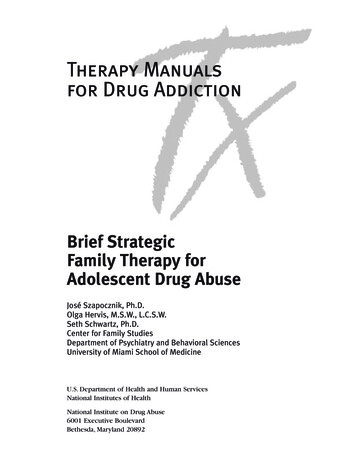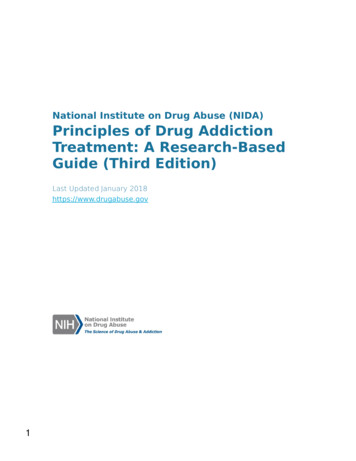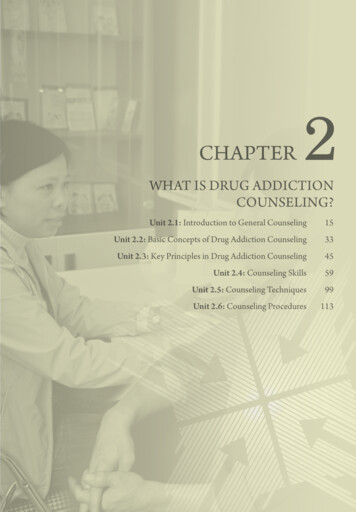
Transcription
CHAPTER2What is Drug AddictionCounseling?Unit 2.1: Introduction to General Counseling15Unit 2.2: Basic Concepts of Drug Addiction Counseling33Unit 2.3: Key Principles in Drug Addiction Counseling45Unit 2.4: Counseling Skills59Unit 2.5: Counseling Techniques99Unit 2.6: Counseling Procedures113
Unit2.1Introduction toGENERAL counseling
OverviewI. Introduction1 MinIntroduce the unit by explaining that you will discuss the key concepts of generalcounseling.II. Presentation30 MinUse the PowerPoint slides to present the definition of counseling, its aim and key concepts,and the differences between counseling and health education.III. Conclusion9 MinReview the key points of this unit and answer participants’ questions (if any).Unit 2.1: Introduction to General CounselingGoal: To help participants understand the key concepts of general counseling inpreparation for in-depth training on drug addiction counseling.Time: 40 minutesObjectives: At the end of this session, participants will be able to:provide the definition of counselingunderstand the context of counselingunderstand the existing myths about drug use and drug usersstate the differences between counseling and health educationidentify attributes that make an ideal counselorMethodology:PresentationGroup discussionTeaching aids:PowerPoint slidesLCD projectorFlipchart and paperMarkers16Training Curriculum on Drug Addiction Counseling: Trainer Manual
Slide 1INTRODUCTIONTO GENERALCOUNSELINGSay: In this unit we will spend a little time to understand counseling in general, and thenwe will spend some time to discuss the basic principles and key concepts of drug addictioncounseling. Drug treatment counseling is the main focus of this workshop.Chapter II – Unit 2.117
Slide 2LEARNING OBJECTIVESAt the end of this unit, participants will be able to: provide the definition of counseling understand the context of counseling understand the existing myths about drug useand drug users state the difference between counseling andhealth education identify attributes that make an ideal counselorSay: I hope that by the end of this unit, you will be able to:18provide the definition of counselingunderstand the context of counselingunderstand the existing myths about drug use and drug usersstate the differences between counseling and health educationidentify attributes that make an ideal counselorTraining Curriculum on Drug Addiction Counseling: Trainer Manual
Slide 3CONTEXT FOR COUNSELING (1)Drug users:experience discrimination, stigmatization andrejection in societyoften viewed as criminals and outcasts and atarget for society’s anger and fearTeaching instructions: Show only the title of this slide, and the reveal the bullets asinstructed below.Say: First of all, we need to know the context for counseling.Teaching instructions: Guide a discussion on the context for counseling by askingopen-ended questions such as:Who are the kinds of people who come for counseling?What are the kinds of things that individuals returning from drug rehabilitationcenters feel?What are some the attitudes of the community towards these people?What are individuals' concerns when they seek counseling?How might they expect you to help them?Show the bullets for Slide 3 while summarizing the participants’ answers. Spend sometime to explore what the participants think about why a drug user comes to see acounselor.Say: Can you tell me why drug users come to seek counseling?Answers might include:They are forced by parents, the community, and/or law enforcement agencies.They come for methadone treatment, not for counseling, but counseling was apart of treatment, so they joined.Chapter II – Unit 2.119
Slide 3 (cont.)They know that counselors can help.They come to please someone such as a spouse partner, family member etc.They want to quit or reduce their drug use.Teaching instructions: Spend some time to explore what the participants think aboutwhy a drug user does not come to a counselor.Say: So why do you think drug users do not seek counseling?Answers might include:Many of them think/believe that only they know their problems and no one elsecan help.They deny that they have a drug problem.They are too proud to talk about their personal issues, faults or weaknesses.They are afraid of breach of confidentiality.They have failed many times before and do not want to try again.They had a bad experience with a previous counselor who dictated terms ororders for them.Counselors have not used drugs so drug users think they won’t understand.Say: In their daily lives, drug users experience discrimination, stigmatization and rejection.They are often viewed as criminals and outcasts and a target for the community's anger and fear.20Training Curriculum on Drug Addiction Counseling: Trainer Manual
Slide 4CONTEXT FOR COUNSELING (2)What do drug users worry about?Further discriminationTheir futureOthers talking about their drug useLack of treatment accessCounseling won't workLack of treatment (HIV)Teaching instructions: Show only the title and the question under the title for thisslide, and then reveal the bullets after conducting the discussion below.Say: As a counselor, it is important for you to understand drug users’ worries.Teaching instructions: Guide a discussion on the possible worries a drug user mighthave. Reveal the bullets after participants have had a chance to discuss and contribute.Then proceed with the suggested wording below.Say: So, when clients come to you for counseling, you have an opportunity to help themunderstand how counseling can help relieve many of the worries that they may have. You willlearn many techniques and skills throughout this training to assist your clients and alleviatetheir worries.Chapter II – Unit 2.121
Slide 5MYTHS ABOUT DRUG USE“People who use drugs are always morally weak.”“Addicts are beyond help.”“All drug users are drug addicts.”“All drug users are criminals.”Teaching instructions: Show the title of this slide only, and then reveal the bullets afterthe discussion below.Say: Although in recent years there is an increasing number of community educationprograms to raise awareness and understanding about drug use, drug users and communityhealth, there remain many myths about drug users.Teaching instructions: Divide the class into 2 groups and give each group 5 minutes todiscuss myths they have heard about drug use and drug users. Ask 1 group to presentthe myths they have brainstormed, and ask the second group to add any missing ideas.Say: Why do you think I asked you to discuss myths you have heard?FYI: It is important for participants to recognize that many myths are commonly spreadthroughout their communities. The discussion exercise is designed to show that even inseparate groups, they are likely to come up with some of the same myths.Teaching instructions: Show Slide 5.Say: Which of these do you think are myths and which do you think are true?Teaching instructions: If time is available, you can explain more about some pointsthat may sometimes be true (e.g. “Drug users are criminals.”)22Training Curriculum on Drug Addiction Counseling: Trainer Manual
Slide 5 (cont.)FYI: Drug users often resort to crime to pay for their drugs. Some drug users are criminalsbefore they start using drugs. Many people in the community feel that drug addiction is amoral weakness and do not understand that it is a chronic relapsing disorder that involveschanges in the brain, body, and spirit of the drug user. They do not understand that thesechanges make it difficult for some individuals to avoid using drugs.Chapter II – Unit 2.123
Slide 6WHAT IS COUNSELING?Counseling is an interactive exchange processbetween counselors and clients to help clientsconfidentially explore their problems and enhancetheir capacity to solve their own problems.Say: So what is counseling? Counseling is the purposeful act of providing professionalguidance. It utilizes various psychological methods and techniques to guide the client in aconstructive direction.There are some key words that I want to discuss in more detail with you.One is the word intervention. Counseling is an intervention. When you provide guidance orassist a client in making a decision, you intervene in order to help that person to achieve adesired outcome.I would also like to discuss the phrase “ confidentially explore their problems ”. Althoughindividuals may come to talk to a counselor about their problems, they often want to be surethat their visit and information is kept confidential. Remember: counseling deals with sensitiveissues and breaking confidentiality could cause serious problems.Then the last part of the definition I would like to discuss is “ enhance their capacity to solvetheir own problems.” In order to be effective, counseling must be client - centered, based onindividual needs. The goal and objectives of counseling should be negotiated between theclient and the counselor. Ultimately, clients should feel empowered to solve their problems ontheir own. The counselor assists clients to understand what options are available to them, andto make informed decisions on how best to proceed.24Training Curriculum on Drug Addiction Counseling: Trainer Manual
Slide 7AIM OF COUNSELINGHelps clients take charge of their lives by:developing their ability to make wise and realisticdecisionsassisting them to alter their own behavior toproduce desirable resultsproviding information for informed decisionmakingCounseling can be for individuals, couples, groups orfamiliesSay: Counseling is catered to the specific needs, issues and circumstances of each individualclient. It is an interactive, collaborative and respectful process that helps clients developautonomy and responsibility for themselves. Counseling should also be focused, with specificgoals obtained by asking questions, eliciting information, reviewing options and developingaction plans. It takes into account an individual's social and cultural context, and readinessto change.Counseling can be provided to individuals, couples, groups or families.Chapter II – Unit 2.125
Slide 8COUNSELING IS NOTTelling or directingA conversationAn interrogationA confessionPrayingSay: Counseling is most effective when it is voluntary. It is not possible to direct individualsto change their behavior. The use of motivational interviewing, which will be covered later inthis training course, provides a mechanism for encouraging change.Conversations are a mechanism for exchange of information, but they are not purposefulin changing behavior. Counseling provides more than just a conversation in that it providesdirection and guidance for behavior change.Collaboration in effective counseling is essential; it is important to remain open-minded andflexible in your approach. If you appear to be too intrusive into clients' thoughts and behaviors,they may react by refusing to cooperate with you.Remember that counseling is an interactive process through which both counselor and clientcooperate on achieving agreed upon short-term goals. You place your faith in each other,rather than in a higher being.26Training Curriculum on Drug Addiction Counseling: Trainer Manual
Slide 9WHAT IS THE DIFFERENCE BETWEENCOUNSELING AND HEALTH EDUCATION? (1)CounselingHealth EducationConfidentialUsually “one-to-one” orsmall groupEvokes strong emotions inboth client and counselorCounselor listens attentively and reflectsFocused, specific andgoal-orientedNot usually confidentialSmall or large groups ofpeopleEmotionally neutral innatureHealth educator talks moreGeneralizedTeaching instructions: Show only the title for Slide 9, and then reveal the informationin Slides 9 and 10 after facilitating small- and then large-group discussions about thedifference between a health educator and a counselor.Divide the class into 2 groups and give each group 5 minutes to discuss theirunderstanding of the differences between counseling and health education. Ask 1group to take 2-3 minutes to present their findings. Ask the second group to add anymissing thoughts. Then present the slides and discuss any issues the group did notraise. Make sure participants discuss respect for confidentiality as a key principle thatcounselors must maintain at all times.Chapter II – Unit 2.127
Slide 10WHAT IS THE DIFFERENCE BETWEENCOUNSELING AND HEALTH EDUCATION? (2)CounselingHealth educationInformation used tochange attitudes andmotivate behaviorchangeInformation used toincrease knowledge andto educateIssue-orientedContent-orientedBased on needs ofthe clientsBased on public healthneedsSay: A person can be both a counselor and a health educator. But the most important thingis that the person knows which job he/she is doing. Former health educator counselors mayoften confuse the 2 roles. Remember to set some ground rules with your client before you startthe session. It is appropriate to say that you can provide both education and counseling duringa counseling session.Let's consider an example of the difference between counseling and health education. Inconducting a session on safe sexual practices, health education would entail describing thecorrect use of a condom, while counseling might entail discussing a client's concern about whyhis penis may not stay hard while using a condom.Teaching instructions: Review the bullets on the slide based on what was not coveredin the group discussions.28Training Curriculum on Drug Addiction Counseling: Trainer Manual
Slide 11WHAT ATTRIBUTES MAKEAN IDEAL COUNSELORCreative and imaginativePracticalShows respect for clientAction-orientedDoesn’t impose own views or concernsTeaching instructions: Show only the title for this slide, and then reveal the bulletsafter you have facilitated a large-group discussion.Say: Given the principles of counseling, what qualities do you think make an effective or anideal counselor?Teaching instructions: Wait for the participants to give their ideas and opinions. Thenshow Slide 11 and proceed with the suggested wording below.Say: A good counselor is creative and imaginative and can help clients identify linkagesbetween their thoughts, feelings and behaviors. Many clients will appreciate counselors whocan help them organize and articulate their thoughts around specific goals they would like toachieve. A good counselor is flexible and can give practical guidance on ways that clients canachieve their goals.A mutually respectful relationship will lead to shared communication and agreement on howbest to proceed. It’s critical not to impose your views or concerns on your client, but rather tounderstand his/her views and concerns.Chapter II – Unit 2.129
Slide 12THINGS TO ngOver-interpretingSympathizingJudgingTeaching instructions: Begin with the title of this slide, and reveal each bullet as youdiscuss it.Say: These are things that you need to avoid when providing drug counseling:Moralizing. Remember, the goal of your work is to help clients solve their problems.Never moralize their experience.Ordering. You are their counselor, not their supervisor or employer. You have no rightto tell your clients what to do.Threatening. Try to avoid attitudes or language that make your clients feel that theyare threatened. You should provide a supportive environment for your clients to sharetheir problems.Arguing. Clients may not heed your advice and may use words that hurt you. Staycalm and help them understand that they have the right to make their own decisionsand that you will respect those decisions.Disagreeing. Your task is not to determine what is wrong and what is right.This may lead to disagreement between you and your client, which can stall thecounseling process.Over-interpreting. A counselor's job is to understand his/her clients and to link theirthoughts and goals with a coherent plan. Counselors must avoid overinterpretingwhat clients are telling them. Over-interpreting may lead to misunderstandingsof, or inappropriate focus on, some of the factors that are critical in influencingbehavior change.Sympathizing. We will discuss empathy and sympathy later. A professional counselorshould not become emotionally involved during the counseling session.30Training Curriculum on Drug Addiction Counseling: Trainer Manual
Slide 12 (cont.)Judging. Counseling assists clients to identify what puts them at risk. Judging yourclient may lead to mistrust and denial of problems. You should listen without judging,criticizing or blaming, and try to gain a better understanding of your client from his/her viewpoint.Chapter II – Unit 2.131
Slide 13SUMMARYCounseling helps clients take charge of their lives.Counseling can be provided to individuals, couplesor families.An ideal counselor is creative and imaginative, has apractical approach, is able to show respect forclients, is action-oriented and does not imposehis/her own views or concerns.Counseling is different from health education.Teaching instructions: Review the key messages of this unit.FYI: CounselingHelps individuals to take charge of their lives by:helping them to develop the ability to make wise and realistic decisionsaltering their behavior to produce desirable consequencesproviding them useful information for informed decision makingCan be for individuals, couples or familiesShould be provided by counselors who are creative and imaginative, use apractical approach, are able to show respect for their clients, are action-oriented,and do not impose their own views or concernsIs different from health educationTeaching instructions: Thank the participants for their participation in the discussionsand ask them if they have any questions. Answer the questions that pertain to this unit.If participants ask questions about material that will be covered in a later unit, requestthat they save their questions for that unit.32Training Curriculum on Drug Addiction Counseling: Trainer Manual
2.2UnitBASIC CONCEPTS OF DRUGADDICTION COUNSELING
OverviewI. Introduction1 MinIntroduce the unit by explaining that you will discuss the basic concepts of drug addictioncounseling.II. Presentation25 MinUse the PowerPoint slides to present the key concepts of drug addiction counseling, thecontext for counseling, the issues surrounding stereotypes and myths about drug users,and the role of drug addiction counseling.III. Conclusion4 MinReview the key points of this unit and answer participants’ questions (if any).Unit 2.2: Basic Concepts of Drug Addiction CounselingGoal: To ensure participants understand the basic concepts of drug addictiontreatment counseling including its definition and role, the general principles of effectivecommunication, and the difference between empathy and sympathy.Time: 30 minutesObjectives: At the end of this session, participants will be able to:explain the definition of drug addiction counselingexplain the role of drug addiction counselinglist 4 general principles for effective communicationexplain the differences between empathy and sympathyMethodology:PresentationDiscussionTeaching aids:PowerPoint slidesLCD projectorFlipchart and paperMarkers34Training Curriculum on Drug Addiction Counseling: Trainer Manual
Slide 1BASIC CONCEPTS OFDRUG ADDICTIONCOUNSELINGSay: As a counselor, you are going to play a very important role in supporting your clientsto take responsibility for themselves by setting goals and making informed decisions. To beeffective, you will need to understand the basic concepts of drug addiction counseling.Chapter II – Unit 2.235
Slide 2LEARNING OBJECTIVESAt the end of this unit, you will know:explain the definition of drug addiction counselingexplain the role of drug addiction counseling:- how to encourage and motivate clients to reducetheir drug use-related risk- how to support clients to seek care and supportlist 4 general principles for effective communicationexplain the differences between empathy andsympathyTeaching instructions: Use the bullets on this slide to present directly.36Training Curriculum on Drug Addiction Counseling: Trainer Manual
Slide 3DRUG ADDICTION COUNSELINGWhat is drug addiction counseling?An intervention which gives the client an opportunityto explore his or her drug use and consequencesconfidentially, and to discuss available treatmentoptions most appropriate to his/her circumstancesWhy is drug addiction counseling needed?- to encourage and motivate clients to reduce theirdrug use-related risks- to support clients in seeking care and support- drug users who wish to stop using drugs oftenbenefit from counseling in combination withtreatment optionsTeaching instructions: Show only the title of this slide and proceed with the discussionbelow before revealing the bullets.Say: We have already discussed counseling in general terms. Now we will discuss drugaddiction counseling. Remember, not everyone who uses drugs is addicted to drugs. Can youtell me why drug users come to a counselor?Teaching instructions: Allow participants a few moments to respond. There are noright or wrong answers. Make sure you address issues that have not been discussedby helpingparticipants to understand the rationale of drug counseling, which includesencouraging and motivating clients to reduce their drug use-related risks andsupporting them to seek care and support.Say: Addiction to drugs can be difficult to overcome for many individuals. Drug addictioncounseling provides guidance on strategies to assist clients to reduce risks associated withusing drugs and, if desired, to abstain from drug use. Counseling can be effective in reducingboth drug use and the harm associated with drug use. Drug addiction counseling enablesclients to link the problems they may have to their drug use, and to identify tangible solutions.Many of the skills and techniques that will be taught in this course are based on cognitivebehavioral frameworks that have been shown to be effective in assisting drug users to stopusing drugs.Teaching instructions: Reveal the information on Slide 3.Chapter II – Unit 2.237
Slide 3 (cont.)Say: So what is drug addiction counseling?Counseling is the purposeful act of providing professional guidance. It utilizes variouspsychological methods and techniques to guide the client in a constructive direction.There are some key words that I need to discuss regarding drug addiction counseling in moredetail with you.One is the word "intervention". Drug addiction counseling is an intervention. When youprovide guidance or assist someone to makie a decision, you intervene in order to help thatperson to achieve a desired outcome.I would also like to discuss the phrase “ to explore his or her drug use confidentially ” Thisis important because drug use and misuse is illegal, and people do not want to be identifiedas users. Although users may come to a counselor in order to discuss their problems, most willwant to be sure that everything is kept confidential. Remember: drug use is a sensitive issueand breaking confidentiality could cause serious problems.The last part of the definition; “ to discuss options about available treatments mostappropriate to his/her circumstances” indicates the expected goal and objectives of thecounseling session. In order to be effective, drug addiction counseling must be client-centered,based on individual needs. The goal and objectives of counseling should be negotiated betweenthe client and the counselor. Ultimately, clients should feel empowered to solve their problemson their own. The counselor assists clients to understand available treatment options , and tomake informed decisions on how best to proceed.38Training Curriculum on Drug Addiction Counseling: Trainer Manual
Slide 4ROLE OF COUNSELINGCounseling sessions help clients:reduce risk or stop drug useset goals and develop plansdevelop problem solving and refusal skillsidentify risky situationsidentify ways to deal with riskTeaching instructions: Show the title of the slide, and reveal each bullet as you discussthem.Say: I want to emphasize the role that drug addiction counseling plays in assisting clients toreduce risk and/or abstain from drug use.The role of drug addiction counseling is to:help clients to reduce risk or stop drug usehelp set goals and develop plansdevelop problem solving and refusal skillsidentify risky situationsidentify ways to deal with riskDrug addiction counselors provide guidance and advice to assist clients to realize their goalsthrough the development of specific skills and techniques. Informal communication incounseling sessions helps to enable clients to acquire these skills. We will now discuss thesecommunication attributes in greater detail.Chapter II – Unit 2.239
Slide 5COMMUNICATION ATTRIBUTESEffective communication:- clear and non-judgmental- assists in building rapport- develops a sense of trustEffective communication is the key in:- undertaking a quality assessment- managing drug -related problemsSay: Effective communication is an essential component of drug addiction counseling.Information exchange is greatly enhanced when counselors adhere to a few basic principlesof effective communication. Effective communication is clear and non-judgmental. This helpsto build rapport and a sense of trust between client and counselor.We have also discussed the principles of voluntary participation in counseling, showing respectfor the client, and developing trust. Effective communication is also crucial in undertaking aquality assessment and managing drug-related problems.40Training Curriculum on Drug Addiction Counseling: Trainer Manual
Slide 6GENERAL PRINCIPLESOF COMMUNICATIONDevelop rapport and a sense of trustAttend to the person’s immediate concernsShow concern about the client’s drug use problems without prejudiceUse appropriate language to overcome potentialcommunication barriersSay: Effective communication involves developing rapport and a sense of trust. Forexample, non-verbal cues such as your body position, facial expressions and other gestureshave meaning and influence the way your communication is interpreted. Sitting at a largedistance from your clients may make them feel safe, but it may also make them feel that youdo not want to have close contact with them.If you speak their language by using words that they usually use, your clients may feel morecomfortable because they will feel that you understand them.Attend to the person’s immediate concerns. Your clients may express various needs andrequest your support. It is important to listen to them and help them feel that they are beinglistened to. Make an effort to understand what their immediate needs are and address themfirst. Be honest with them and tell them that you may need more time to understand and workwith them on ways to address some of their other needs.Show concern about their drug use problems without prejudice.Use appropriate language to overcome potential communication barriers. Languagecan be verbal or non-verbal (so be aware of your body language). Your communication styleis very important. When you are engaged, your eyes should be warm and inviting; they shouldshow you are interested in what they have to say.Chapter II – Unit 2.241
Slide 7EMPATHY VS SYMPATHYEmpathize- Listen to and understand client's experiencefrom his/her perspective- Not always in agreement- Summarize and provide feedback- Help client find own solutions- Client's suffering is not your burdenSympathize- Always side with client- Emotionally involved- Experience as if burden is sharedSay: Do you understand the difference between empathizing and sympathizing?Teaching instructions: Allow the participants some time to discuss the differences.Say: In drug addiction counseling, which of the two do you think works best: empathizingor sympathizing?Teaching instructions: Make sure the participants understand that a professionalcounselor understands clearly the difference between empathy and sympathy.Say: A counselor successfully expresses empathy toward clients by listening andunderstanding what they are going through. Counselors are not obligated to agree with theirclients, but they must not be judgmental in disagreeing. The counselor provides feedback andhelps clients find their own solutions. Counselors should avoid sympathizing, should not takesides, and should not get emotionally involved as that will undermine the potential benefits ofcounseling and can cause counselor burnout.Empathizing means understanding the circumstances, the situation, and what is happeningto the client. It does not mean sharing emotions. In empathizing, one is objective andcompassionate without being overly emotionally involved. Sympathizing is agreeing with theperson, feeling their emotions, and being on their side.When you sympathize, your clients no longer have you as a counselor; they might do just aswell talking to themselves in a mirror. You stop being objective and reflective; you are just thesame as your clients.42Training Curriculum on Drug Addiction Counseling: Trainer Manual
Slide 7 (cont.)In empathizing, you understand what the person has gone through: their suffering, pain, andhurt. But when you become sympathetic, you carry their pain and agree wholeheartedly withthem, and you lose the ability to be an effective counselor.Chapter II – Unit 2.243
Slide 8SUMMARYDrug addiction counseling is- an intervention, confidential, provides optionsRole of drug addiction counseling- to encourage and motivate client, to reduce risksassociated with drug use- to support clients to seek care and supportEffective communication- develops rapport, responds to immediate concerns- shows concern without prejudice- uses appropriate languageEmpathy works, sympathy doesn’tTeaching instructions: Review the key messages of this unit.FYI:Drug addiction counseling is an intervention that gives the client an opportunityto explore his or her drug use confidentially and to discuss available treatmentthat are most
preparation for in-depth training on drug addiction counseling. Time: 40 minutes Objectives: At the end of this session, participants will be able to: provide the definition of counseling understand the context of counseling understand the existing myths about drug use and drug users state the differences between counseling and health education
